Discovering Penina Moise
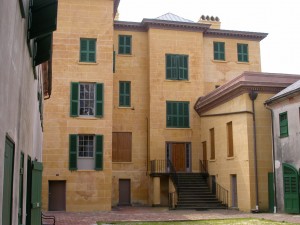
More “on the road” notes from Julia’s mom:
On Tuesday morning, we toured the Aiken-Rhett House, one of Charleston’s many historic homes. The home was built in 1817, when Penina Moise would have been 20. The house has been modified very little since 1858. We walked through the main mansion, the slave quarters, carriage house and kitchens. The grandeur of the house shone through the faded layers of paper and paint. An art gallery still holds sculptures and paintings brought back from a grand tour through Europe in the 1850s.
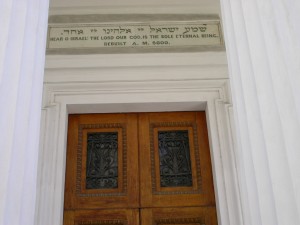 In the afternoon, we met with Anita Moise Rosenberg, the great grand niece of Penina Moise. She met us at Kahal Kadosh Beth Elohim, the synagogue Penina Moise attended and helped to rebuild after it was destroyed by fire in 1838. The hymns Penina wrote were sung in the sanctuary for many years and are still performed there on special occasions. Also, Penina Moise was the superintendent of the Hebrew school at the synagogue.
In the afternoon, we met with Anita Moise Rosenberg, the great grand niece of Penina Moise. She met us at Kahal Kadosh Beth Elohim, the synagogue Penina Moise attended and helped to rebuild after it was destroyed by fire in 1838. The hymns Penina wrote were sung in the sanctuary for many years and are still performed there on special occasions. Also, Penina Moise was the superintendent of the Hebrew school at the synagogue.
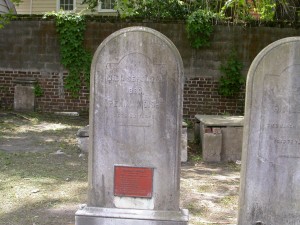 After showing us the magnificent sanctuary and a collection of portraits and artifacts connected with the Moise family, Anita drove us to the Coming Street Cemetery, where Penina, her parents, brother Abraham and niece Jacqueline are interred. Julia and Barrie both put rocks on the graves and brushed away some leaves and grass clippings. Julia said that it was sad to see the grave because it showed her that Penina had died. When reading her poetry, Julia has been impressed with the vivid imagery Penina uses to describe biblical figures like Noach and Yosef. I think the strength of Penina’s words became very present to Julia, so it was difficult for Julia to see first hand that Penina was no longer living.
After showing us the magnificent sanctuary and a collection of portraits and artifacts connected with the Moise family, Anita drove us to the Coming Street Cemetery, where Penina, her parents, brother Abraham and niece Jacqueline are interred. Julia and Barrie both put rocks on the graves and brushed away some leaves and grass clippings. Julia said that it was sad to see the grave because it showed her that Penina had died. When reading her poetry, Julia has been impressed with the vivid imagery Penina uses to describe biblical figures like Noach and Yosef. I think the strength of Penina’s words became very present to Julia, so it was difficult for Julia to see first hand that Penina was no longer living.
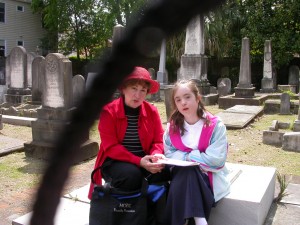 Julia also interviewed Anita about her family. The Moise family can trace its roots to 1492.
Julia also interviewed Anita about her family. The Moise family can trace its roots to 1492.
The Coming Street Cemetery is also the resting place of several heroes of the Revolutionary War, many founders of Charleston’s business, artistic, and Jewish communities, and four of the eleven founders of Masonry’s Scottish Rite.
Anita then drove us down to the Battery to see the canons, explained the unique features of Charleston architecture and pointed out many landmarks.
Before taking us to the cemetery, Anita showed us a small gray house, no longer square, at 5 Coming Street. After the Civil War, when Penina Moise returned to Charleston from her wartime refuge in Sumter, she lived in this house with her niece Jacqueline. The two of them ran a school. Penina taught literature and religion from memory, as she had lost most of her sight. The house is unmarked and in disrepair. We returned there after dinner to have a closer look. Julia was sad that there was no longer any sign of Penina there. She said that Penina probably did not like to live there even when the house was newer, that it was probably never a nice house.
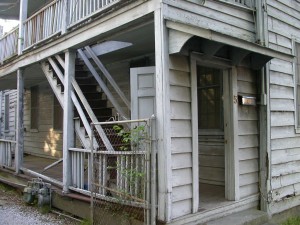 Julia pointed out that Penina Moise probably wrote several of her alphabetical acrostic poems while living at 5 Coming Street. As she could no longer see, Penina would recall literature, authors, geography and other disciplines in alphabetical order as an aid to memory.
Julia pointed out that Penina Moise probably wrote several of her alphabetical acrostic poems while living at 5 Coming Street. As she could no longer see, Penina would recall literature, authors, geography and other disciplines in alphabetical order as an aid to memory.
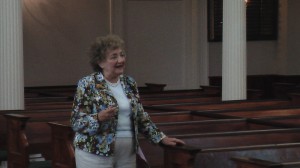 Wednesday morning, docent Carolee Fox gave us a guided tour of the sanctuary at Kahal Kadosh Beth Elohim. The ark is made of mahogany wood from Haiti. Julia remembered that Penina Moise’s parents, Abraham and Sarah Moise, lived in Haiti (then Santo Domingo) before they emigrated to Charleston. Ms. Fox showed us the marks on the sanctuary floor where the original amud stood. Julia was thrilled to see the spot from which Penina Moise would have heard the Torah read. Ms. Fox also explained to us the history of religious freedom guaranteed by the South Carolina Constitution and how groups of all religions cooperate amiably in the city.
Wednesday morning, docent Carolee Fox gave us a guided tour of the sanctuary at Kahal Kadosh Beth Elohim. The ark is made of mahogany wood from Haiti. Julia remembered that Penina Moise’s parents, Abraham and Sarah Moise, lived in Haiti (then Santo Domingo) before they emigrated to Charleston. Ms. Fox showed us the marks on the sanctuary floor where the original amud stood. Julia was thrilled to see the spot from which Penina Moise would have heard the Torah read. Ms. Fox also explained to us the history of religious freedom guaranteed by the South Carolina Constitution and how groups of all religions cooperate amiably in the city.
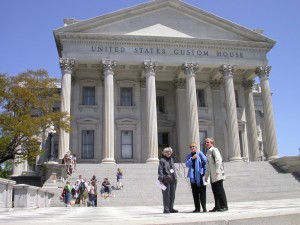 Afterward, we toured the covered market, now a gift and craft mall that was formerly a fruit and vegetable market. Julia posits that Penina Moise would have done her grocery shopping for Shabbat at this market. From the market, we continued toward the river to the U.S. Customs House, in continuous use for about 150 years. Back to Pita King (great fries!), then on the road again to Yulee, Florida.
Afterward, we toured the covered market, now a gift and craft mall that was formerly a fruit and vegetable market. Julia posits that Penina Moise would have done her grocery shopping for Shabbat at this market. From the market, we continued toward the river to the U.S. Customs House, in continuous use for about 150 years. Back to Pita King (great fries!), then on the road again to Yulee, Florida.
With the end of the on site research comes the beginning of writing the book, checking and rechecking the facts and continuing to solicit input from the experts. Julia is eager to start writing, but not tonight. It’s going to be a long drive tomorrow, and we could all use some sleep.
A special thanks to Barrie Miller, Julia’s sister, for taking so many of the above photographs and being such an excellent helper.
You are doing a very great thing by showing the world more about Penina Moise.
Thou rockest, o small one. Sharma (who is on the desk in front of my monitor) concurs.
Anti-Marna and the Bunny Man and Sharma Kitty >^.^<
Dear Julia,
You are doing a great job. Your work will teach a lot of people abut a very gifted, dedicated woman in the history of the Jews in the United States.
I am so proud of you.
Love,
Bubby